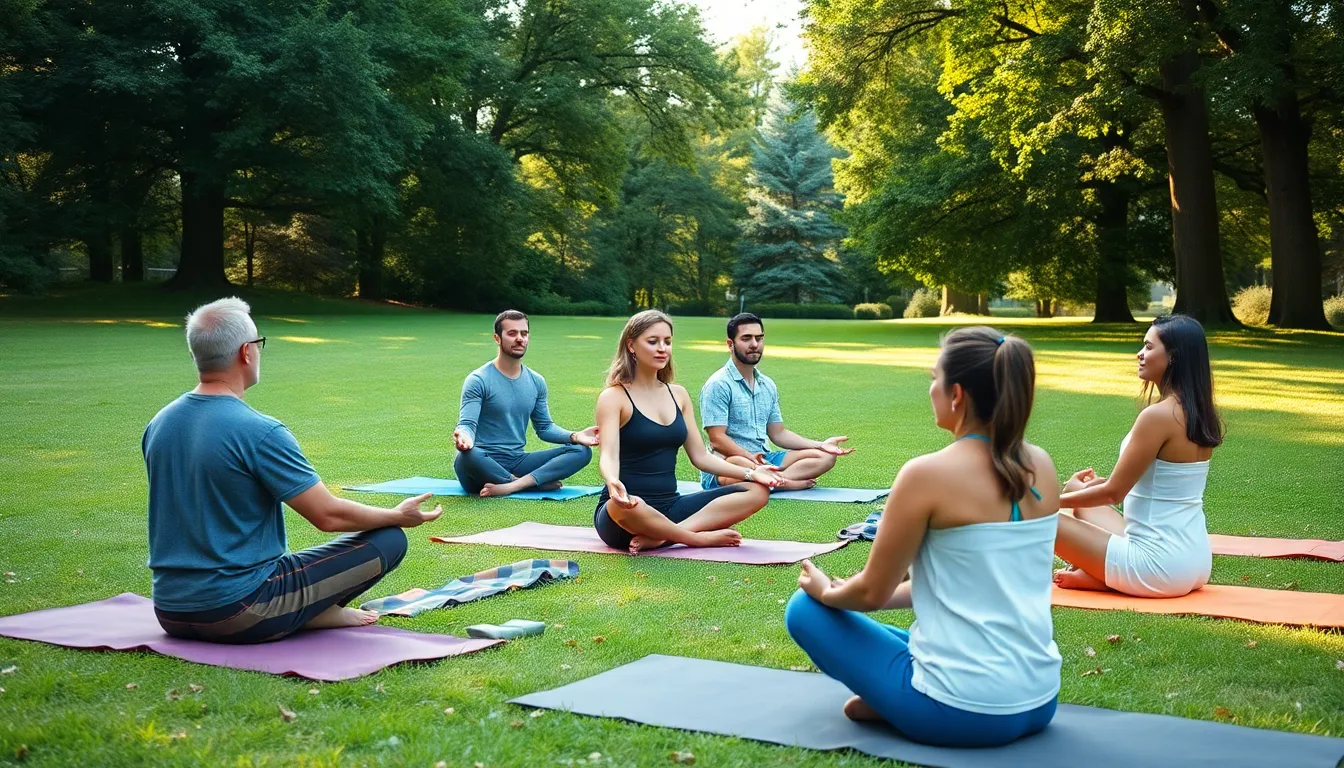Table of Contents
ToggleIn a world buzzing with distractions, mindfulness practices offer a refreshing escape. Imagine being able to hit the pause button on life’s chaos and focus on the present moment—sounds dreamy, right? Whether it’s sipping coffee without scrolling through your phone or taking a deep breath instead of losing it over a missed deadline, mindfulness can transform everyday experiences into moments of zen.
But don’t worry, mindfulness doesn’t require a degree in meditation or hours of sitting cross-legged on the floor. It’s about finding simple ways to reconnect with oneself and the world around them. From breathing exercises that take less time than a cat video to walking meditations that even the busiest bees can fit into their schedules, mindfulness is here to help. So, let’s dive into the art of being present and discover how these practices can make life a little less hectic and a lot more enjoyable.
Overview of Mindfulness Practices
Mindfulness practices center on cultivating awareness and presence in daily life. Simple techniques, like focused breathing, can anchor individuals in the current moment. Breathing exercises offer quick relief from stress and help regulate emotions. Walking meditations encourage movement while fostering a sense of connection to one’s surroundings. These practices require minimal time, making them accessible for busy schedules.
Daily routines can seamlessly incorporate mindfulness, enhancing the quality of everyday activities. Engaging in mindful eating transforms mealtime into a sensory experience, promoting appreciation for food and its flavors. Guided meditations provide structure and support, especially for beginners looking to delve deeper into mindfulness.
Regular practice leads to improved mental clarity and emotional resilience. Research shows that mindfulness reduces symptoms of anxiety and depression by fostering a non-judgmental awareness of thoughts and feelings. Incorporating mindfulness into group settings, such as workplaces or schools, can also enhance overall well-being.
Participants in mindfulness courses often report increased focus and productivity alongside decreased stress levels. The flexibility of these practices allows individuals to tailor their experiences based on personal preferences, whether through formal sessions or spontaneous moments throughout the day. As individuals explore various mindfulness techniques, each practice serves as a tool to cultivate inner peace and enhance daily living.
Benefits of Mindfulness Practices

Mindfulness practices offer significant benefits for both mental and physical health, promoting a balanced lifestyle amidst the distractions of daily life.
Mental Health Improvements
Reduction in anxiety and depression symptoms often occurs with consistent mindfulness practice. Studies indicate that mindfulness improves emotional resilience and enhances focus. Participants commonly report greater mental clarity and an ability to manage stress effectively. Increased self-awareness leads to better coping strategies, making challenging situations more manageable. Emotional regulation improves through techniques such as focused breathing and guided meditation, fostering a sense of calm. Improvements in mental health contribute to higher levels of overall well-being, creating a more enjoyable daily experience.
Physical Health Benefits
Physical health benefits derive from mindfulness as well. Regular practice can lower blood pressure and improve heart health. Research shows mindfulness reduces chronic pain and enhances immune function. Engaging in mindful eating promotes healthier food choices and improves digestion. Many individuals notice a significant increase in energy levels, which supports an active lifestyle. Additionally, mindfulness encourages better sleep hygiene, leading to improved recovery and overall health. Overall, incorporating mindfulness practices into daily life contributes to lasting physical wellness.
Common Mindfulness Practices
Mindfulness practices can significantly enhance daily living. Various techniques cultivate greater awareness and presence, helping individuals navigate life’s demands.
Meditation Techniques
Meditation techniques range from simple breath awareness to guided sessions. Practitioners often find that focused meditation fosters deeper concentration. Techniques such as body scan or loving-kindness provide unique benefits. Some prefer transcending thoughts in vipassana meditation, finding clarity and insight. Beginners might choose apps that offer structured guidance, making entry into meditation smooth and accessible.
Breathing Exercises
Breathing exercises serve as quick stress relief tools. Simple patterns like inhaling deeply for four counts, holding for seven, and exhaling for eight can promote relaxation. Many individuals practice diaphragmatic breathing, which encourages full oxygen exchange. Others incorporate techniques like box breathing, which centers attention and calms the mind. Regular incorporation of these exercises helps in boosting emotional regulation.
Mindful Eating
Mindful eating transforms mealtime into a sensory experience. By paying full attention to each bite, individuals enhance their appreciation for food. Savoring flavors and textures leads to healthier food choices. Practitioners often report increased satisfaction and avoid overeating. Setting a peaceful atmosphere during meals further enriches this practice, creating space for gratitude and enjoyment.
Integrating Mindfulness into Daily Life
Integrating mindfulness into daily life enhances overall well-being. Simple strategies make it easier to practice mindfulness consistently.
Tips for Practicing Mindfulness
Start by focusing on your breath. Bringing attention to each inhale and exhale grounds an individual in the present moment. Observe surrounding sensations, such as sounds or smells, to enhance awareness. Engaging in a daily gratitude practice promotes positive thinking. Combining mindfulness with routine activities, like showering or drinking coffee, strengthens awareness. Practicing these techniques fosters emotional regulation and stress relief.
Creating a Mindfulness Routine
Establishing a mindfulness routine supports consistent practice. Designate specific times for mindfulness, such as morning or evening. Incorporating short meditation sessions of five to ten minutes encourages discipline. Utilize guided meditations for structure, especially for beginners. Setting reminders on mobile devices reinforces commitment to practice. Engaging in mindful eating during meals promotes appreciation for food. Embracing these steps gradually creates a sustainable mindfulness practice and cultivates lasting benefits.
Challenges in Mindfulness Practices
Mindfulness practices face various challenges that can hinder their effectiveness. Identifying these obstacles allows individuals to navigate their journey with greater clarity.
Overcoming Obstacles
Finding distractions during mindfulness sessions often proves challenging. Environmental noise, intrusive thoughts, and personal stressors can disrupt focus. Practitioners commonly experience frustration when results don’t manifest quickly. Acknowledging these feelings becomes crucial for maintaining motivation. Techniques such as setting a specific time or place for practice foster a more conducive atmosphere. Engaging in short, manageable sessions eases frustration, making it easier to return to focus. With patience and practice, individuals build resilience against these challenges over time.
Staying Consistent
Remaining consistent in mindfulness practices presents its own difficulties. Busy schedules frequently impede regular practice, leading to missed opportunities for growth. Creating a set routine significantly enhances adherence to mindfulness techniques. Incorporating reminders, like setting alarms or using apps, supports daily engagement. Starting with brief, focused sessions helps establish a foundation, allowing participants to gradually increase duration. Accountability through partnerships or community groups enhances commitment. Ultimately, establishing consistency transforms mindfulness into an integral part of daily life, yielding lasting benefits.
Embracing mindfulness practices can profoundly impact daily life. By incorporating simple techniques into routines individuals can experience greater emotional resilience and reduced stress. These practices not only enhance personal well-being but also foster a more focused and productive environment in group settings.
As individuals navigate the challenges of modern living it’s essential to remember that mindfulness is accessible to everyone. With just a few moments dedicated each day individuals can transform their experiences and cultivate a deeper appreciation for the present.
Ultimately the journey toward mindfulness is personal and flexible. Each small step taken can lead to significant improvements in mental and physical health, making it a valuable addition to anyone’s lifestyle.







